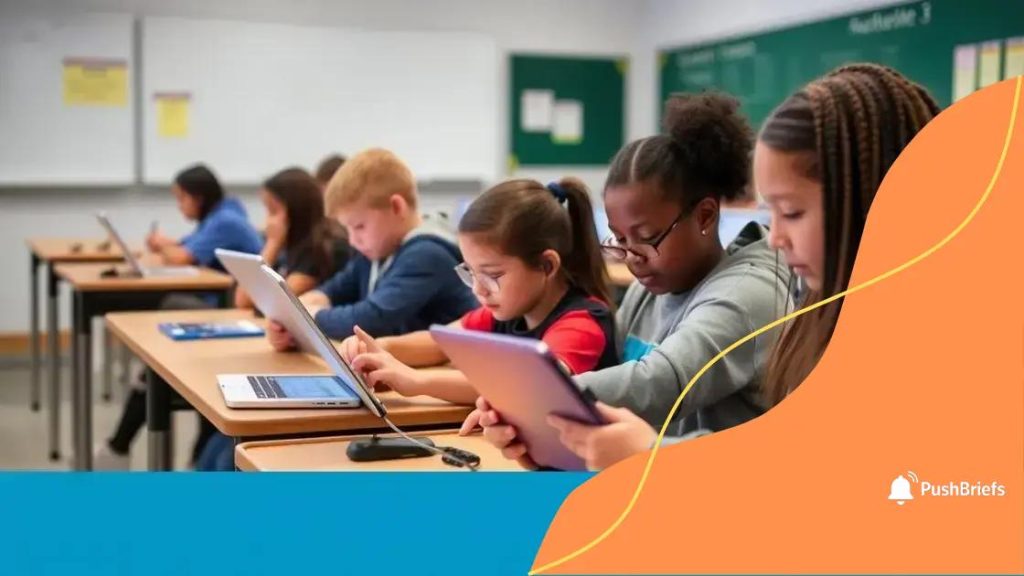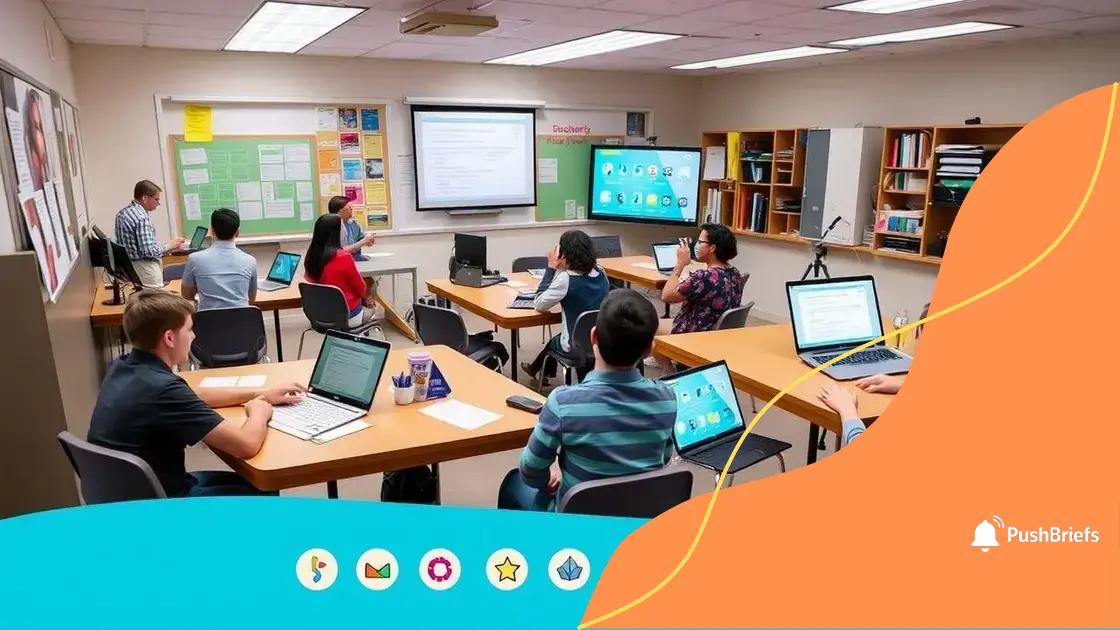EdTech integration challenges: overcoming barriers to success

Sustainable EdTech implementation involves assessing needs, building a strong infrastructure, providing continuous teacher training, and regularly evaluating tools to ensure effective technology integration in education.
EdTech integration challenges can seem daunting for educators and institutions alike. But what if tackling these issues could transform the way we approach learning? Let’s dive into how we can effectively address these obstacles.
Identifying the main barriers to EdTech integration
Identifying the main barriers to EdTech integration is crucial for creating a successful learning environment. Many schools encounter challenges that hinder the implementation of educational technology.
Lack of Training
One significant barrier is the lack of proper training for educators. When teachers are not well-informed about how to use EdTech tools, they often feel overwhelmed. This leads to disengagement and a lack of effective teaching methods.
Resistance to Change
Another obstacle is resistance to change from staff and administration. Many educators may prefer traditional teaching methods, fearing that new technologies will complicate their workflow. This mindset can slow down EdTech integration.
To encourage a shift in perspective, it’s important to illustrate the benefits of using EdTech in classrooms. For example, using interactive platforms can engage students and make lessons more enjoyable. Additionally, showcasing success stories from other institutions can inspire confidence.
Budget Constraints
Budget constraints also play a significant role in EdTech integration. Schools must allocate funds for software, hardware, and training. Without proper funding, even the best tools may go unused.
Incorporating EdTech effectively requires a clear understanding of these barriers. Each challenge must be addressed thoughtfully, creating a roadmap for seamless integration that ultimately benefits students and educators alike.
Impact of teacher training on EdTech success
The impact of teacher training on EdTech success is profound. Proper training equips educators with the skills they need to effectively use technology in the classroom.
Building Confidence
When teachers receive training, they build confidence in using new tools. Educational technology can seem intimidating, but training sessions provide a safe space to learn and practice. This confidence translates to students, who benefit from engaged and knowledgeable instructors.
Enhancing Pedagogy
Effective training enhances pedagogical strategies as well. Educators learn how to integrate EdTech into their lessons, making learning more interactive and engaging for students. This not only increases student interest but also improves learning outcomes.
Moreover, technology allows for personalized learning experiences. Teachers who are trained can better utilize data and analytics to tailor lessons to meet individual student needs, creating a more inclusive classroom environment.
Long-Term Benefits
In the long term, schools that prioritize teacher training in EdTech see sustained benefits. New tools and platforms continuously emerge, and having a well-trained staff ensures that schools can adapt to these changes.
Ultimately, the investment in teacher training forms the foundation for successful EdTech integration and a richer learning experience for all students.
How to engage students in digital classrooms

Engaging students in digital classrooms is essential for effective learning. When classes shift to online formats, it can be challenging to maintain student interest and participation.
Interactive Learning Activities
One effective way to engage students is through interactive learning activities. Using tools like quizzes, polls, and interactive simulations can create a dynamic learning environment. Engaging students keeps them motivated and involved in their education.
Personalized Learning Experiences
Another strategy is to offer personalized learning experiences. By recognizing students’ interests and strengths, educators can tailor lessons to meet individual needs. This approach encourages students to take ownership of their learning.
For instance, using adaptive learning programs allows students to learn at their own pace. It also allows teachers to focus on areas where students may need additional support. Such strategies not only enhance engagement but also promote a deeper understanding of the material.
Building a Supportive Community
Creating a supportive online community is vital for student engagement. Teachers can foster this sense of community by encouraging open communication and collaboration among students.
When students feel connected and supported, they are more likely to participate actively in their digital classrooms. Implementing these strategies can significantly enhance the overall learning experience and make digital education more effective.
Measuring the effectiveness of EdTech tools
Measuring the effectiveness of EdTech tools is crucial for understanding their impact on learning outcomes. Schools must evaluate whether these tools enhance educational experiences and improve student performance.
Defining Key Metrics
To effectively measure success, it is essential to establish key metrics. These metrics can include student engagement, academic performance, and user satisfaction. By defining these aspects, educators can gather meaningful data that reflects the tools’ effectiveness.
Data Collection Methods
Various data collection methods can help assess the effectiveness of EdTech. Surveys, quizzes, and observational studies can provide valuable insights. For instance, using online quizzes allows teachers to see immediate results and adjust teaching methods accordingly.
Another approach is to conduct longitudinal studies, tracking student progress over time. This method offers a comprehensive view of how EdTech influences learning and retention.
Continuous Improvement
Continuously reviewing and analyzing data is vital for maximizing the benefits of EdTech tools. Schools should regularly assess the effectiveness of their tools and make adjustments based on data findings.
By focusing on continuous improvement, schools can ensure that their investments in EdTech lead to enhanced student outcomes and a more effective learning environment.
Strategies for sustainable EdTech implementation
Implementing sustainable EdTech strategies is essential for ensuring long-term success in education. Schools need to integrate technology effectively while considering resources and potential challenges.
Assessing Needs and Goals
The first step in sustainable implementation is to assess the specific needs and goals of the school or district. This involves gathering input from teachers, students, and parents. Understanding their needs helps identify which technologies will best support learning.
Building a Strong Infrastructure
A robust infrastructure is crucial for successful EdTech implementation. Schools must ensure they have the necessary hardware, software, and internet connectivity. This foundation allows for consistent access and reliable performance of educational tools.
Additionally, technical support should be available. Training staff on how to troubleshoot common problems can minimize downtime and ensure smooth operation.
Creating Professional Development Programs
Professional development is vital for sustaining the use of educational technology. Investing in ongoing training for teachers empowers them to innovate with technology.
Moreover, schools should foster a culture of collaboration where teachers share their successes and challenges with various EdTech tools. This sharing can inspire others to explore new techniques and resources.
Regular Evaluation and Feedback
Lastly, continuous evaluation is key to sustainable EdTech implementation. Regularly assessing the impact of technology on teaching and learning allows educators to make necessary adjustments.
By focusing on sustainability, schools can effectively implement EdTech tools that enhance learning and meet the needs of students and teachers over time.
FAQ – Frequently Asked Questions about Sustainable EdTech Implementation
What are sustainable EdTech strategies?
Sustainable EdTech strategies focus on implementing technology in ways that ensure long-term effectiveness and adaptability in educational settings.
How can I engage students in a digital classroom?
Engaging students can be achieved through interactive learning activities, personalized experiences, and creating a supportive online community.
Why is teacher training important for EdTech?
Teacher training is crucial because it empowers educators to effectively integrate technology into their lessons, enhancing student learning and engagement.
How can I measure the effectiveness of EdTech tools?
You can measure effectiveness by tracking key metrics such as student performance, engagement levels, and gathering feedback from both students and teachers.
